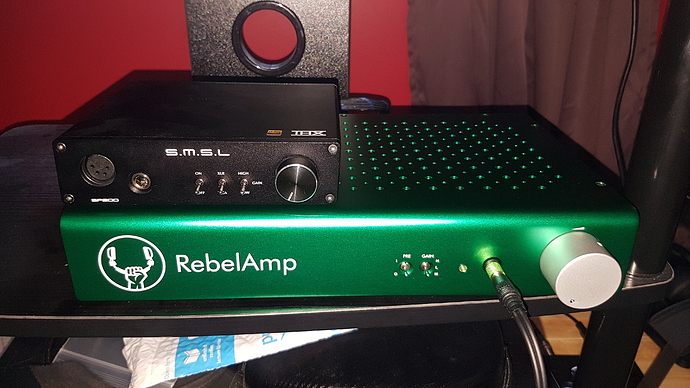When it gets back in stock I’m ordering one lol, I just don’t know when it will get back in stock
I knew you didn’t like THX very much, but this is the first time I have seen you murder it 

I guess you haven’t seen some of the other threads lol
Apparently not, now I am even more curious haha
I am very curious as to how this compares to the Flux FA-10. I told myself endgame already but now that I’ve gotten my taste of Class A, I’ve gotta have more… which is actually a very stupid thought since my HP-3’s require next to nothing at 25 ohms. Someone else do it for me lmao. Someone with hungry cans.
Initial impressions of the RebelAmp are very good with my Sundara’s. It is definitely a different presentation than the smsl-sp200. More to come in a few days… just over 100 hours of break-in now so I will be diving into comparisons this weekend.
Ok here it goes…
First off I will say that both my SMSL-SP200 and the RebelAmp are staying. They are not that much alike and as such, I think they complement each other very well. Both amps have good detail retrieval and plenty of power for the headphones I have. This is the type of amp that tells you to sit back and relax, let the music flow over you. The SparkNotes version of this experience is the RebelAmp presents details in a way that is more pleasing to my ears and I will attempt to outline what I mean below. Firstly, the SMSL-SP200 has a narrow soundstage (or some would say exactly what the track intends). While the RebelAmp has a wider soundstage. I first noticed this when listening with my HD6xx which has been described as “in your head” sound. With the SMSL-SP200 it is definitely an in your head experience. With the RebelAmp the soundstage is definitely wider. The next upside of the RebelAmp can also very easily be a downside depending on your cans. My Hifiman Sundaras can be a bit aggressive in the highs with the SMSL-SP200. When paired with the RebelAmp that slight peakiness is never a problem and the soundstage is nice and wide. However, when paired with the HD6xx on some songs it can be a bit too warm for my taste. Both the HD6xx and the Sundara sound beautiful when running off of the RebelAmp, there is zero fatigue and the sound wraps you up. If you are looking for a super analytical sound I would say stick with a THX amp. But if you are looking for something different give this a shot. So at the end of the day, it does come down to pairings but I can say the RebelAmp is here to stay as it offers something very different from the SMSL-SP200.
I will be receiving my set of long-awaited Meze Empyreans in the next few weeks and I will post my thoughts on them paired with the RebelAmp (originally ordered the Empyreans on Jan 31st!).
Awaits RebelAmp + Empyrean photos… hifi pron.
I love how the green looks. What DAC are you using?
Chord Qutest set at 2v using the white neutral filter.
How does using the Rebel Amp as a preamp to the SMSL THX effect the sound? If the THX is ‘transparent’ wouldn’t it just boost the volume?
I’m not sure. I will give it a shot.
Double amping like this is generally not a good idea.
What are you trying to achieve?
The amps are intended to take input signals at ~2V (4V balanced), but will output much greater voltages that that, so you have to be careful. Most likely if you get the first amp too loud it will just clip, but it could cause damage.
No amp is transparent
Preamp out of the rebel into the smsl-sp200 will not damage anything. Headphone out into the smsl-sp200 is another story.
Yes if it has a pre-out, it will be fine, I’m just not sure what the point would be.
There are measurement amps for lab use that are 99% flat in a certain limited window.
Even if that’s true that’s just frequency response, says nothing about time domain effects (impulse response etc) or phase.
So let’s string a bunch of these together in parallel in sort of a switching setup, sum the signals and create a super amp for the objectivist crowd. (Sort of like 5 mini lion robots coming together to form 1 giant lion robot).
Perfect, lab measured frequency response for only $150k!!!
You may end up closer to that price than you think…
Those internally-compensating Op-Amps are in the 100 to 150€ per piece range.
My product idea was facetious of course, but I really was trying to guess at the cost. I used the price of am AP analyzer as a foundation and then scaled up from there. Glad to hear I was in the ballpark!! 



It’s true with everything that that last tiny bit of performance is very costly!
